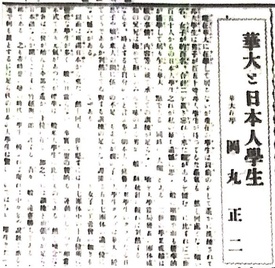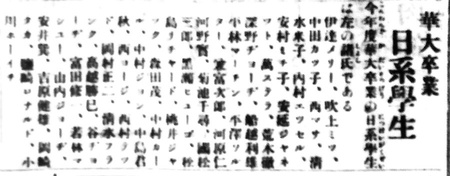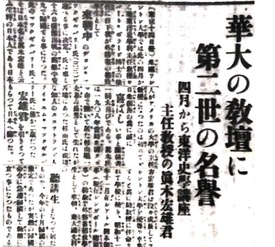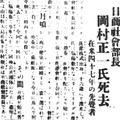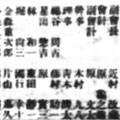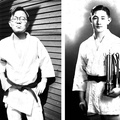In the last chapter, I wrote about the problem of Nisei’s dual citizenship and their marriage. This chapter shares The North American Times articles1 about colleges that Nisei attended. Many Niseis went to college, which is a higher educational institution in America. They learned and acquired state-of-the-art technology and knowledge in hopes of later being able to contribute to the Nikkei community.
ADMISSION TO THE UNIVERSITY OF WASHINGTON
We can find the history of the University of Washington (UW) in an article, “The UW and Japanese Students,” published in the January 1, 1939 issue. It was written by Shoji Okamaru, who himself was the UW student at that time.
The UW was established in 1861, a quarter of a century earlier than Tokyo Imperial University. It kept growing and now (1939) is a well-known school in the country. It boasts having 12,000 students on its 550 acres of campus with its gorgeously beautiful design exemplified in the Gothic-style building, which is said to have cost at least 15 million dollars.
The UW is known for the nickname “Huskies,” and it is a well-known fact that they won the gold medal in Sailing at the Berlin Olympics (1936).
The University of Washington was the venue of the Alaska-Yukon-Pacific Exposition in 1909, which I introduced in Chapter 9 of the series.
I found some articles reporting the Japanese students who attended and graduated from the University of Washington around 1919.
“New School Year at the UW” (April 2, 1919 issue)
Today is the first day of the new school year at the UW. More than 1,200 students have registered as of yesterday. Two Japanese students newly entered.
“This Year’s Fellow Graduates” (June 4, 1919 issue)
The UW had three Japanese graduates this year. Out of seven high school graduates, two have already entered the engineering department. Three will start this October.
In the previously mentioned article “The UW and Japanese Students,” Shoji Okamaru talked in detail about the Japanese students who attended the University of Washington.
Currently (1939), there is a total of 250 Japanese students at UW; about 150 of whom are male and 100 are female. . . .It used to be that many students came from Japan, all so vigorous, generally in Japanese style and full of energy. These days the majority of them are Nisei and we rarely hear the students speak Japanese. This is also due to the change in time and is nothing to be surprised about, but it seems like the students today have lost the energy that the Japanese students had back in the day. . . .
This is not intended, however, to speak badly of Nisei. In fact, the academic levels of Nisei are far above those of regular white students. Japanese college students today when compared with students in our generation are smarter. And they are far more sophisticated. When compared with Issei who somehow looked gloomy, Nisei in general are cheerful and also look healthy.
The academic performance of Nisei is clearly proven when we look at the statistics of group performance announced by the school authorities. The Japanese Student Club, which is comprised of Japanese male students, ranks third out of 57 groups. The female club “Fuyo-kai” is in the 15th place out of 37 groups. . . .
The School of Business, where most Japanese students belong, ranks in the top 10 departments in the nation. Every year we see names of Japanese students on the Dean’s list. Although the Pharmaceutical Department is also famous, it’s almost impossible for Japanese students to get a job after graduation. The Departments of Law, Political Science, Economics, and Journalism, all have great classes and faculty members with their own specialties. . . .
In the Sociology Department, Miyamoto-kun is giving lectures in beginner sociology classes. It seems like he has the most Japanese students. A notable one is the School of Aquatic and Fisheries Sciences which can be found nowhere else in the United States.
Also, Asian Studies is probably the best in the nation. There have been a great number of graduates from the science field such as Mechanical Engineering, Civil Engineering, and Electrical Engineering, as well as other areas. Almost everyone has returned and has been employed in Japan. Many graduates during the war are well-known.
There is the Japanese Student Club built one street across from the UW campus which was funded by a Japanese foundation. The place recently underwent rapid renovation with improved equipment, looking all refreshed and new, with the efforts of volunteer parents and alumni groups. So if you happen to visit the campus, we would like you to stop by the club and see how the Japanese students are doing today. . . .
The good thing is that Nisei are competent, quality-wise. What they are lacking is energy and discipline. If they cultivate social discipline, fight, and perseverance to achieve success in athletic fields, it won’t be difficult at all for them to accomplish something in this soft America.
According to some sources the Japanese Student Club was established in 1921 by some notable figures in Seattle at the time such as Masajiro Furuya, Sumikiyo Arima, Heiji Okuda, and others, with the funding of well over 30,000 dollars. This club was maintained and operated with the fixed amount of monthly donation by Issei and was used to facilitate socialization among students as well as provide accommodations for them.
The Fuyo-kai was formed in 1925 as a sorority for female students who attended the University of Washington.
“Commencement at Nihon Kyokai” (June 2, 1938 issue)
A commencement will be held on the coming 6th of the month for 29 Japanese students graduating from the UW this year. We expect to see a great number of members of Nihon Kyokai (Japan Association) as well as those of the women’s club.
“Japanese Students on the Dean’s List at UW” (January 18, 1939 issue)
Dean Sieg has announced the names of students with academic achievements in the fall quarter at UW, and the Japanese students add up to 35. (names published)
“Nikkei Graduates from UW Receive Bachelor’s Degrees” (January 23, 1939 issue)
At the end of the fall quarter, 175 students at the UW were awarded bachelor’s degrees, teaching certificates, and/or nursing certificates. . . . Of them, five are Japanese students who received their degrees (names published).
“Five Nisei Graduate from UW This Spring” (April 10, 1939 issue)
UW announced the names of 208 students graduating this winter quarter, five of whom are Japanese (names published) and 32 of whom are on the Dean’s list (names published).
“Nikkei Students Graduating from UW” (June 7, 1939 issue)
40 Nikkei students graduate from UW this year (names published).
WHAT TO DO AFTER GRADUATION
Sumiyoshi Arima, President of The North American Times, commented on the future path of graduates in his column “Hokubei Shunju.”
“A message to Nisei Graduates of the UW” (July 19, 1939 issue)
This year the UW has 40 Japanese graduates, 9 of whom are female. Having finished your intended studies, even if some of you will continue your academic journey in each field of interest, you should know that you are now entering the real world. We would like to congratulate you sincerely on this meaningful start and wish you the best in your future endeavors.
You have passed this gateway, called graduation, with great academic achievements. The work that you’ve put in all those years is worth mentioning in itself. At the same time, however, you have to remember that you owe much of it to your parents who made it possible for you to continue your studies and supported you through your academic journey with all their hearts.
Also, don’t forget to be thankful for the support from your community. In fact, the student club house that you have used was made with donations from our peers in the community. We hope that you will continue to strive in your future endeavors with appreciation for your parents and community. . . .
In America there is still much racial prejudice whether we want to admit it or not. There have been a number of cases where highly competent college graduates face various challenges in society simply because of their Japanese heritage. Even if they instead head to Japan, they face different challenges such as the language barrier, cultural differences, and other things, which make it difficult to get the job or social status they want.
Of course, your future is limitless. By all means you should cultivate your talent and skills but at the same time you should keep in mind that you will face some good amount of obstacles on your way. Especially depending on the field of your studies some of you might have a hard time getting jobs in the intended fields. Still, we hope with all our hearts that each one of you will put all your effort into what you do for your future or for the future of the Japanese people.
GREAT ACHIEVEMENTS OF GRADUATES
I found a lot of articles on the graduates of the University of Washington who made great achievements such as becoming college instructors.
“Honored Nisei on Teaching Podium at the UW” (March 14, 1939 issue)
Starting this April, UW has decided to hire John McGilvery (age 33), who is currently visiting Japan as a guest student of the Ministry of Foreign Affairs, as a successor of Dr. Bard Ballard, a chief professor of East Asian history. Mr. McGilvery will return home on Yusen’s ship Heian-maru, which will leave Yokohama on the 16th.
This Mr. McGilvery is a native Japanese, whose Japanese name is Hiroo Maki. Those working in the same field are overjoyed with the fact that a native Japanese became a chief professor at an American university for the first time saying it is such a joyous occasion for developing a good relationship between Japan and the U.S.
Mr. Maki was born in 1908 as the eldest son to his father Jyunichi Sugiyama and his wife who were working in Tacoma City at the time; but as Sugiyama was having a hard time making ends meet he had Noi M. McGilvery, a warm-hearted Scottish, adopt Hiroo who was just two years old and returned to Japan.
Hiroo grew up steadily and was appointed assistant professor when he graduated from the University of Washington cum laude (with honors). In November 1936, he went to Japan as a guest student of the Ministry of Foreign Affairs, which was arranged by Consul Okamoto who was residing in Seattle, and he was there to audit Japanese literature classes at the University of Tokyo. He was scheduled to come back to the States in October this year but was given the order to return suddenly as it was decided that he would come back in a hurry and take the teaching job.
“To the Teaching Podium of UW, Emerging Shinji Kanbe” (July 7, 1939 issue)
After graduating from the University of Washington, the Nisei Shinji Kanbe further majored in anatomy working as a student assistant and was recently appointed associate professor of anatomy.
“Yuichi Hirabayashi Becomes Assistant at Kyoto University” (November 13, 1939 issue)
An honors graduate from the University of Washington with a degree from the School of Business, Yuichi Hirabayashi became an assistant at Kyoto University.
Note:
1. All article excerpts are from The North American Times unless noted otherwise.
*The English version of this series is a collaboration between Discover Nikkei and The North American Post, Seattle’s bilingual community newspaper. This article was originally publishd in Japanese on June 1, 2022 in The North American Post.
© 2022 Ikuo Shinmasu


